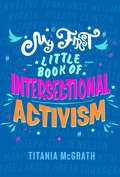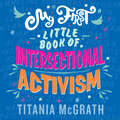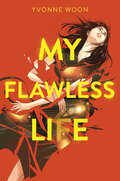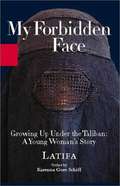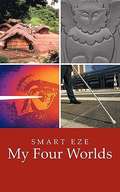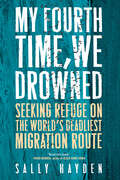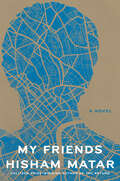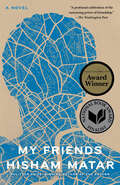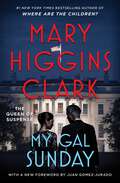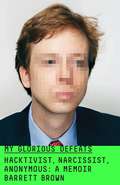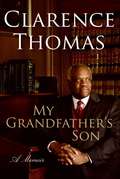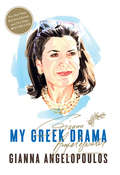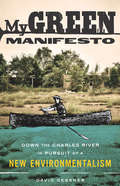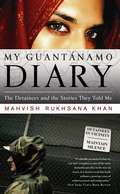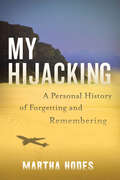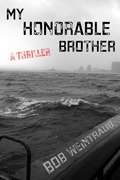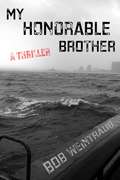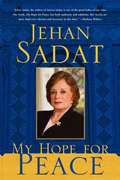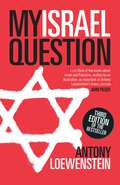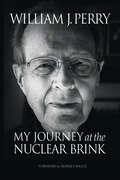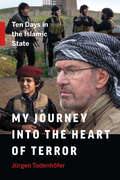- Table View
- List View
My First Little Book of Intersectional Activism
by Titania McGrath'Fabulously smart and entertaining . . . If virtue-signalling wokery drives you as nuts as it drives me, you will love it' Piers Morgan'Required reading for anyone needing an antidote to the mass hysteria of humanity's latest religion' Entertainment FocusAfter the success of her debut Woke: A Guide to Social Justice, radical slam poet and intersectional feminist Titania McGrath has turned her talents to the realm of children's non-fiction. Aimed at activists from the age of six months to six years, Titania's book will help cultivate a new progressive generation. In a series of groundbreaking and poignant chapters, she will take you on a journey with some of the most inspiring individuals in history, such as Emmeline Pankhurst, Meghan Markle, Nelson Mandela, Hillary Clinton and Joseph Stalin. Praise for Woke:'Beautiful classic satire' Ricky Gervais'The latest genius twist in Britain's long tradition of satirical spoof' Daily Express 'Titania McGrath mercilessly satirises the Left's online umbrage brigade, the permanently offended, those who have taken on the role of policing thoughts and words to the point of absurdity' The Herald 'Hilarious' Evening Standard 'Hilarious' Spectator 'Hilarious' The Times 'Utterly unfunny' Peter Hitchens
My First Little Book of Intersectional Activism
by Titania McGrath''Fabulously smart and entertaining . . . If virtue-signalling wokery drives you as nuts as it drives me, you will love it'' Piers Morgan''Required reading for anyone needing an antidote to the mass hysteria of humanity''s latest religion'' Entertainment FocusAfter the success of her debut Woke: A Guide to Social Justice, radical slam poet and intersectional feminist Titania McGrath has turned her talents to the realm of children''s non-fiction. Aimed at activists from the age of six months to six years, Titania''s book will help cultivate a new progressive generation. In a series of groundbreaking and poignant chapters, she will take you on a journey with some of the most inspiring individuals in history, such as Emmeline Pankhurst, Meghan Markle, Nelson Mandela, Hillary Clinton and Joseph Stalin. Praise for Woke:''Beautiful classic satire'' Ricky Gervais''The latest genius twist in Britain''s long tradition of satirical spoof'' Daily Express ''Titania McGrath mercilessly satirises the Left''s online umbrage brigade, the permanently offended, those who have taken on the role of policing thoughts and words to the point of absurdity'' The Herald ''Hilarious'' Evening Standard ''Hilarious'' Spectator ''Hilarious'' The Times ''Utterly unfunny'' Peter Hitchens
My First Little Book of Intersectional Activism
by Titania McGrath'Fabulously smart and entertaining . . . If virtue-signalling wokery drives you as nuts as it drives me, you will love it' Piers Morgan'Required reading for anyone needing an antidote to the mass hysteria of humanity's latest religion' Entertainment FocusAfter the success of her debut Woke: A Guide to Social Justice, radical slam poet and intersectional feminist Titania McGrath has turned her talents to the realm of children's non-fiction. Aimed at activists from the age of six months to six years, Titania's book will help cultivate a new progressive generation. In a series of groundbreaking and poignant chapters, she will take you on a journey with some of the most inspiring individuals in history, such as Emmeline Pankhurst, Meghan Markle, Nelson Mandela, Hillary Clinton and Joseph Stalin. Praise for Woke:'Beautiful classic satire' Ricky Gervais'The latest genius twist in Britain's long tradition of satirical spoof' Daily Express 'Titania McGrath mercilessly satirises the Left's online umbrage brigade, the permanently offended, those who have taken on the role of policing thoughts and words to the point of absurdity' The Herald 'Hilarious' Evening Standard 'Hilarious' Spectator 'Hilarious' The Times 'Utterly unfunny' Peter Hitchens
My Flawless Life
by Yvonne WoonYvonne Woon, author of If You, Then Me, has crafted a slow-burn thriller about fixing—our friends, ourselves, and our complicated pasts. For fans of Allegedly and We Were Liars, My Flawless Life features a compelling narrator who grapples with the secrets of her private school classmates as well as her own life.At the most elite private school in Washington, DC., whenever anyone has a problem that they need to go away, they hire Hana Yang Lerner.Hana is a fixer. She knows who to call, what to say, and how to make sure secrets stay where they belong—buried. She can fix anything. Except her own life, which was destroyed when her father, senator Skip Lerner, was arrested for an accident that left one woman nearly dead.Now Hana’s reputation is ruined and her friends are gone. So when she gets a job from an anonymous client called “Three” to follow her former best friend, Luce Herrera, Hana realizes this might be her way of getting back her old life.But the dangerous thing about digging is that you never know what you’ll unearth. As Hana uncovers a dark truth about her supposedly flawless classmates, she’s forced to face a secret of her own.* A Junior Library Guild Selection *
My Forbidden Face: A Young Woman's Story
by Linda Coverdale Queen LatifahLatifa describes the consequence of the ruthless rule of the Taliban on the dreams and aspirations of young women in Afghanistan.
My Four Worlds
by Smart Eze"My Four Worlds" is the autobiography of a blinded war veteran. Smart Eze, was born in Nigeria, began his education, but was unable to attend college due to financial reasons. Then the Biafran-Nigerian civil war erupted, and he became a Biafran soldier. He was blinded in a bomb explosion at age 23. He was taken to Austria for medical treatment, but remained totally blind. However, he received training in braille, cane use, and other skills. He eventually attended university and earned a Ph.D. He has worked for the United Nations and traveled around the globe. In 2012, he was in the USA training and receiving a guide dog for the blind from Guide Dogs of the Desert in California.
My Fourth Time, We Drowned: Seeking Refuge on the World's Deadliest Migration Route
by Sally HaydenThe Western world has turned its back on migrants, leaving them to cope with one of the most devastating humanitarian crises in history. Reporter Sally Hayden was at home in London when she received a message on Facebook: &“Hi sister Sally, we need your help.&” The sender identified himself as an Eritrean refugee who had been held in a Libyan detention center for months, locked in one big hall with hundreds of others. Now, the city around them was crumbling in a scrimmage between warring factions, and they remained stuck, defenseless, with only one remaining hope: contacting her. Hayden had inadvertently stumbled onto a human rights disaster of epic proportions. From this single message begins a staggering account of the migrant crisis across North Africa, in a groundbreaking work of investigative journalism. With unprecedented access to people currently inside Libyan detention centers, Hayden&’s book is based on interviews with hundreds of refugees and migrants who tried to reach Europe and found themselves stuck in Libya once the EU started funding interceptions in 2017. It is an intimate portrait of life for these detainees, as well as a condemnation of NGOs and the United Nations, whose abdication of international standards will echo throughout history. But most importantly, My Fourth Time, We Drowned shines a light on the resilience of humans: how refugees and migrants locked up for years fall in love, support each other through the hardest times, and carry out small acts of resistance in order to survive in a system that wants them to be silent and disappear.
My Friend the Monster
by Clyde Robert BullaA lonely prince forms a satisfying though dangerous friendship with a monster.
My Friends: A Novel
by Hisham MatarA &“masterly&” (The New York Times), &“riveting&” (The Atlantic) novel of friendship, family, and the unthinkable realities of exile, from the Booker Prize–nominated and Pulitzer Prize–winning author of The Return &“[A] personal, deeply felt work . . . looping back and forth through time and memory, building on itself in a process of gradual expansion and revelation . . . quite simply, dazzling&” —Toronto StarThe trick time plays is to lull us into the belief that everything lasts forever, and although nothing does, we continue, inside our dream.One evening, as a young boy growing up in Benghazi, Khaled hears a bizarre short story read aloud on the radio and has the sense that his life has been changed forever. Obsessed by the power of those words—and by their enigmatic author, Hosam Zawa—Khaled eventually embarks on a journey that will take him far from home, to pursue a life of the mind at the University of Edinburgh.There, thrust into an open society that is light years away from the world he knew in Libya, Khaled begins to change. He attends a protest against the Qaddafi regime in London, only to watch it explode in tragedy. In a flash, Khaled finds himself injured, clinging to life, an exile, unable to leave England. To even tell his mother and father back home what he has done, on tapped phone lines, would mark them for death.When a chance encounter in a hotel brings Khaled face to face with Hosam Zawa, the author of the fateful short story, he is subsumed into the deepest friendship of his life. It is a friendship that not only sustains him, but eventually forces him, as the Arab Spring erupts, to confront agonizing tensions between revolution and safety, family and exile, and how to define his own sense of self against those closest to him.A devastating meditation on friendship and family, and the ways in which time tests—and frays—those bonds, My Friends is an achingly beautiful work of literature by an author working at the peak of his powers.
My Friends: A Novel
by Hisham MatarNATIONAL BOOK AWARD FINALIST • LONGLISTED FOR THE BOOKER PRIZE • A &“masterly&” (The New York Times, Editors&’ Choice), &“riveting&” (The Atlantic) novel of friendship, family, and the unthinkable realities of exile, from the Pulitzer Prize–winning author of The Return&“A profound celebration of the sustaining power of friendship, of the ways we mold ourselves against the indentations of those few people whom fate presses against us.&”—The Washington PostONE OF THE WASHINGTON POST AND PUBLISHER WEEKLY&’S TEN BEST BOOKS OF THE YEAR • A BEST BOOK OF THE YEAR: The New Yorker, The Boston Globe, Time, NPR, BookPageWINNER OF THE ORWELL PRIZE FOR POLITICAL FICTION • LONGLISTED FOR THE ANDREW CARNEGIE MEDAL FOR EXCELLENCE IN FICTION AND THE NATIONAL BOOK CRITICS CIRCLE AWARDOne evening, as a young boy growing up in Benghazi, Khaled hears a bizarre short story read aloud on the radio, about a man being eaten alive by a cat, and has the sense that his life has been changed forever. Obsessed by the power of those words—and by their enigmatic author, Hosam Zowa—Khaled eventually embarks on a journey that will take him far from home, to pursue a life of the mind at the University of Edinburgh.There, thrust into an open society that is miles away from the world he knew in Libya, Khaled begins to change. He attends a protest against the Qaddafi regime in London, only to watch it explode into tragedy. In a flash, Khaled finds himself injured, clinging to life, unable to leave Britain, much less return to the country of his birth. To even tell his mother and father back home what he has done, on tapped phone lines, would expose them to danger.When a chance encounter in a hotel brings Khaled face-to-face with Hosam Zowa, the author of the fateful short story, he is subsumed into the deepest friendship of his life. It is a friendship that not only sustains him but eventually forces him, as the Arab Spring erupts, to confront agonizing tensions between revolution and safety, family and exile, and how to define his own sense of self against those closest to him.A devastating meditation on friendship and family, and the ways in which time tests—and frays—those bonds, My Friends is an achingly beautiful work of literature by an author working at the peak of his powers.
My Gal Sunday
by Mary Higgins ClarkA dashing ex-president and his young congresswoman bride become an irresistible sleuthing duo in four acclaimed stories from the #1 New York Times bestselling Queen of Suspense.Henry Parker Britland IV—wealthy, worldly, and popular—is enjoying an early retirement. His new wife, Sunday—as clever as she is lovely—has just been elected to Congress in a stunning upset victory that has made her a media darling. Henry and Sunday make a formidable team...and never more so than when they set out to solve baffling high-society crimes. From a long-unsolved case they reconstruct aboard the presidential yacht to a kidnapping that brings Henry frantically back to the White House, the former president and his bride engage in some of the most audacious and original sleuthing ever imagined. Only Mary Higgins Clark can so seamlessly meld spellbinding suspense, wit, and romance. My Gal Sunday is entertainment of the highest order.
My Glorious Defeats: Hacktivist, Narcissist, Anonymous: A Memoir
by Barrett BrownBarrett Brown went to prison for four years for leaking intelligence documents. He was released to Trump’s America. This is his story.After a series of escapades both online and off that brought him in and out of 4chan forums, the halls of power, heroin addiction, and federal prison, Barrett Brown is a free man. He was arrested for his part in an attempt to catalog, interpret, and disseminate top-secret documents exposed in a security lapse by the intelligence contractor Stratfor in 2011. An influential journalist who is also active in the hacktivist collective Anonymous, Brown recounts exploits from a life shaped by an often self-destructive drive to speak truth to power. With inimitable wit and style, palpable anger and conviction, he exposes the incompetence and injustices that plague media and politics, reflects on the successes and failures of the transparency movement, and shows the way forward in harnessing digital communication tools for collective action.But My Glorious Defeats is more than just the tale of the clever and hilarious Brown; it’s also a rigorously researched dissection of our decaying institutions and of human nature itself. As Brown makes clear, institutions are made of people—people with personal ambitions and personal vices—and it is people, just like him, just like us, who hold power. As optimistic as it is heartbreaking, My Glorious Defeats is an entertaining and illuminating manual for insurgency in the information age.
My Grandfather's Son
by Clarence ThomasAutobiography of the Supreme Court justice, from his early years of poverty and hunger through his years at Yale Law School to his highly contested appointment to the Supreme Court
My Greek Drama: Life, Love, and One Woman's Olympic Effort to Bring Glory to Her Country
by Gianna AngelopoulosNEW YORK TIMES BESTSELLER WALL STREET JOURNAL BESTSELLER Now with a new foreword by the author celebrating the five-year anniversary of her sweeping, inspiring memoir. The world had doubted Greece's ability to successfully stage the 2004 Olympic Games. In rescuing the Athens Olympics and delivering what IOC President Jacques Rogge called an "unforgettable dream games," Gianna Angelopoulos also delivered a new Greece, a modern can-do nation, a Greece worthy of its illustrious heritage. Little did she know that a few years later her country would abandon the lessons of the Olympics and become embroiled in a political and economic crisis that would devastate Greece and threaten the economic security of Europe. My Greek Drama captures the burning ambition of the rebellious girl from the island of Crete who ''lit'' the Olympic torch. Her story should help rekindle the spirit of the Greek people, and of every person who has ever struggled to change the world.
My Green Manifesto: Down the Charles River in Pursuit of a New Environmentalism
by David GessnerAll environmentalism is local: “A wonderfully readable book” about saving the planet by focusing first on our own habitats (The Boston Globe).Though environmental awareness is on the rise, our march toward ecological collapse continues. What was once a movement based primarily on land preservation, endangered species, and policy reform is now a fractured mess of back-to-the-landers, capitalist “green lifestyle” vendors, technology worshipers, and countless special interest groups.Inspired by a rough-and-tumble journey across country and down river, David Gessner, a John Burroughs Award winner, makes the case for a new environmentalism. In a frank, funny, and incisive call to arms that spans from the Cape Wind Project to the Monkey Wrench Gang, he considers why we do or do not fight to protect and restore wilderness, and reminds us why it’s time to join the fray.Known as an environmental advocate “reminiscent of Edward Abbey” (Library Journal), Gessner rebels against this fragmented environmentalism and holier-than-thou posturing. He also suggests that global problems, though real, are disempowering. While introducing us to lovable, stubborn Dan Driscoll, “a regular guy fighting a local fight for a limited wilderness,” he argues for a movement focused on local issues and grounded in a more basic, more holistic—and ultimately more effective—defense of home.“Funny and inspiring.” —Publishers Weekly (starred review)
My GuantÁnamo Diary: The Detainees and the Stories They Told Me
by Mahvish Rukhsana KhanMahvish Khan is the only Afghan-American to walk into Guantanamo of her own accord. This unique book is her story, and the story of the men she grew to know uniquely well inside the cages of Guantanamo. Mahvish Khan is an American lawyer, born to immigrant Afghan parents. She was outraged that her country, the USA, seemed to have suspended its tradition of equality for all under the law with regard to those imprisoned at Guantanamo Bay in Cuba, and so she volunteered to translate for the lawyers - including British lawyer and founder of Reprieve Clive Stafford Smith - acting pro bono for the prisoners. Because she spoke their language, understood their customs and brought them Starbucks chai, the closest available drink to the kind of tea they would drink at home, they quickly befriended her, offering fatherly advice as well as a uniquely personal insight into their plight, and that of their families thousands of miles away at home. Some at Guantanamo are terrorists who deserve to be convicted and sentenced as such. Some are paediatricians and school teachers. We cannot tell the difference until we see them as individuals with their own unique stories. They deserve that much. No other writer has had access to the detainees. This book is a testament to their captivity. It documents the voices of men who have been tortured and held in a black hole of indefinite detention without legal recourse for years. It shows who they are and also allows readers to see that these men are more similar to us than they are different.
My Havana
by Xenia Reloba de la Cruz Maria Carida Cumana Karen DubinskyFor more than thirty years, musician Carlos Varela has been a guide to the heart, soul, and sound of Havana. One of the best known singer-songwriters to emerge out of the Cuban nueva trova movement, Varela has toured in North America, the Caribbean, Latin America, and Europe. In North America, Varela is "Cuba's Bob Dylan." In Cuba, he is the voice of the generation that came of age in the 1990s and for whom his songs are their generation's anthems. My Havana is a lyrical exploration of Varela's life and work, and of the vibrant musical, literary, and cinematic culture of his generation.Popular both among Cubans on the island and in the diaspora, Varela is legendary for the intense political honesty of lyrics. He is one of the most important musicians in the Cuban scene today. In My Havana, writers living in Canada, Cuba, the United States, and Great Britain use Varela's life and music to explore the history and cultural politics of contemporary Cuba. The book also contains an extended interview with Varela and English translations of the lyrics to all his recorded songs, most of which are appearing in print for the very first time.
My Hijacking: A Personal History of Forgetting and Remembering
by Martha HodesIn this moving and thought-provoking memoir, a historian offers a personal look at the fallibilities of memory and the lingering impact of trauma as she goes back fifty years to tell the story of being a passenger on an airliner hijacked in 1970.On September 6, 1970, twelve-year-old Martha Hodes and her thirteen-year-old sister were flying unaccompanied back to New York City from Israel when their plane was hijacked by members of the Popular Front for the Liberation of Palestine and forced to land in the Jordan desert. Too young to understand the sheer gravity of the Israeli-Palestinian conflict, Martha coped by suppressing her fear and anxiety. Nearly a half-century later, her memories of those six days and nights as a hostage are hazy and scattered. Was it the passage of so much time, or that her family couldn’t endure the full story, or had trauma made her repress such an intense life-and-death experience? A professional historian, Martha wanted to find out.Drawing on deep archival research, childhood memories, and conversations with relatives, friends, and fellow hostages, Martha Hodes sets out to re-create what happened to her, and what it was like for those at home desperately hoping for her return. Thrown together inside a stifling jetliner, the hostages forged friendships, provoked conflicts, and dreamed up distractions. Learning about the lives and causes of their captors—some of them kind, some frightening—the sisters pondered a deadly divide that continues today. A thrilling tale of fear, denial, and empathy, My Hijacking sheds light on the hostage crisis that shocked the world, as the author comes to a deeper understanding of both what happened in the Jordan desert in 1970 and her own fractured family and childhood sorrows.
My Honorable Brother
by Bob WeintraubFor Sal, running for governor was better than death at the mob's hands, if only the sex wouldn't get in the way.Mob head Sal Tarantino doesn't want big-time casino gambling to become legal in Rhode Island. His solution is to have to have the next governor comfortably in his pocket and ready to veto the legislation. The means calling in the debts owed to the mob by some of Rhode Island's most prominent politicians to clear the way for Doug Fiore, managing partner of the state's largest law firm and soon-to-be reluctant gubernatorial candidate.Sal's plan seems to be going smoothly until the primary draws closer, when Fiore's opponent, a supporter of state-sponsored gambling and the leader in the polls, is gunned down in a bar along with the establishment's bookie-in-residence. The public presumption, driven by columns in the Providence Herald in which Fiore's ties to the family are laid out, is that the Tarantino family had reasons to want them both dead. Things get even stickier when the winner of the Democratic primary is the husband of one of Fiore's law partners-who happens to also be one of his two mistresses. She learns with horror that her husband has a set of secret recordings taken in a hotel room where Fiore has met with both women.As the race draws to a close, the candidates are in a dead heat. Fiore, who now will stop at nothing to win, devises a scheme with both his mistresses to nail down his victory. The outcome is all in the sex.
My Honorable Brother: A Thriller
by Bob WeintraubA gritty political thriller in which a race for governor is rocked by sex scandals, mob hits, and one candidate’s blind ambition . . . To stop the legalization of big-time casino gambling in Rhode Island, mob boss Sal Tarantino calls in debts owed by some of the state’s most prominent politicians, clearing the way for reluctant gubernatorial candidate Doug Fiore. But when Fiore’s primary opponent, who’s leading in the polls, is gunned down in a bar, the public presumption is that the Tarantino family had reasons to want him dead. Things get even stickier when the husband of one of Fiore’s mistresses wins the Democratic primary—a man who possesses secret recordings that implicate Fiore in two affairs. As the race draws to a close, the candidates are in a dead heat. Fiore, who now will stop at nothing to win, moves to nail down his victory with an audacious scheme—involving both his mistresses . . .
My Hope for Peace
by Jehan SadatFrom the former First Lady of Egypt, New York Times best-selling author, crusader for women's rights, and widow of the slain Nobel Peace Prize winner Anwar Sadat, comes a timely, clear-eyed examination of the defining issues of the Middle East.teps that will lead to their resolution. With a wit and charm developed over fifty years in the public eye, Mrs. Sadat draws on her personal experiences, from her career as first lady of Egypt to her further and yet greater commitments to peace in her widowhood, to explain plainly and frankly the historical, political, and religious underpinnings of the peace process, which many in the West have yet to understand. Along the way, she outlines the origins of modern Islamic terrorism, something she has confronted both politically and personally; she addresses the attendant misconceptions about her faith; and she debunks many of the myths of Muslim womanhood, not least by displaying the clear-eyed passion and political acumen that have earned her worldwide admiration.
My Husband and I: The Inside Story of 70 Years of the Royal Marriage
by Ingrid SewardWith interest in the royal couple at a new peak thanks to the hit TV series The Crown, Ingrid Seward reveals the real story of the marriage of Queen Elizabeth and Prince Philip. When a young Princess Elizabeth met and fell in love with the dashing Naval Lieutenant Prince Philip of Greece and Denmark, it wasn't without its problems. The romance between the sailor prince and the young princess brought a splash of colour to a nation still in the grip of post-war austerity. When they married in Westminster Abbey in November 1947, there were 3000 guests, including six kings and seven queens. Within five years, as Queen Elizabeth II, she would ascend to the throne and later be crowned in front of millions watching through the new medium of television. Throughout her record-breaking reign, she relied on the formidable partnership she had made with her consort. Now, after 70 years of their marriage, acclaimed royal biographer Ingrid Seward sheds new light on their relationship and its impact on their family and on the nation. In My Husband and I, we discover the challenges faced by Prince Philip as he has had to learn to play second fiddle to the Queen in all their public engagements, but we also get a revealing insight into how their relationship operates behind closed doors. As the years have gone by, there have been rumours of marital troubles, fierce debates over how to bring up their children, and they have had to deal with family traumas - from scandalous divorces to shocking deaths - in the full glare of the public eye. But somehow, their relationship has endured and provided a model of constancy to inspire all around them.This book is not only a vivid portrait of a hugely important marriage, it is a celebration of the power of love.
My Israel Question: Reframing The Israel/Palestine Conflict
by Antony LoewensteinAntony's Loewenstein's My Israel Question was a bestseller when first published and generated a storm of controversy, critical praise and robust public debate. Loewenstein's forensic discussion of the Israeli-Palestinian conflict continues here in a fully updated and expanded new edition, examining the prospects of the Middle East peace process in the new geo-political context. The election of Barack Obama brought hope to millions around the world and has seen renewed diplomatic efforts in the Middle East. Yet the Israel-Palestine conflict remains mired in brutality and occupation. The election of a far-right Israeli government, the indiscriminate war on Gaza and the illegal expansion of West Bank colonies suggest a bleak future for both Israelis and Palestinians. However, public debate about the issue, in the USA, United Kingdom, Europe and Australia, is suggesting alternative ways of tackling the crisis. Now, Antony Loewenstein maps the way in which the conflict is ferociously discussed and where the hope lies for resolution to the brutal impasse.
My Journey at the Nuclear Brink
by William PerryMy Journey at the Nuclear Brink is a continuation of William J. Perry's efforts to keep the world safe from a nuclear catastrophe. It tells the story of his coming of age in the nuclear era, his role in trying to shape and contain it, and how his thinking has changed about the threat these weapons pose. In a remarkable career, Perry has dealt firsthand with the changing nuclear threat. Decades of experience and special access to top-secret knowledge of strategic nuclear options have given Perry a unique, and chilling, vantage point from which to conclude that nuclear weapons endanger our security rather than securing it. This book traces his thought process as he journeys from the Cuban Missile Crisis, to crafting a defense strategy in the Carter Administration to offset the Soviets' numeric superiority in conventional forces, to presiding over the dismantling of more than 8,000 nuclear weapons in the Clinton Administration, and to his creation in 2007, with George Shultz, Sam Nunn, and Henry Kissinger, of the Nuclear Security Project to articulate their vision of a world free from nuclear weapons and to lay out the urgent steps needed to reduce nuclear dangers.
My Journey into the Heart of Terror: Ten Days in the Islamic State
by Jürgen TodenhöferAn alarming and enlightening first-hand account of what's really going on behind the borders of the Islamic State.ISIS, IS, the Islamic State. The name is chilling. The images are horrific. This is a group that beheads journalists-and yet one, the German Jürgen Todenhöfer, went out of his way to get an invitation to visit ISIS fighters in Mosul in 2014 to ask them to explain their beliefs. This book is the result of his conversation. My Journey into the Heart of Terror: Ten Days in the Islamic State shows how the organization grew from its al-Qaeda roots and takes a harsh look at the West's role in its past and today. Along the way, Todenhöfer offers startling insights into what ISIS thinks, what it wants-and what must change if it is to be defeated. Only by understanding, Todenhöfer believes, can we move forward and combat ISIS's radical, violent interpretation of Islam and the terror and destruction it brings.
